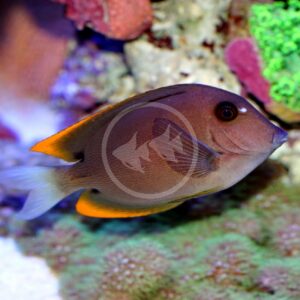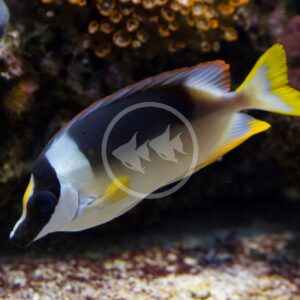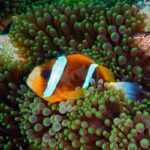
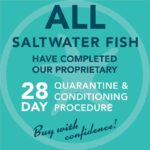
CLOWN – BARRIER REEF YELLOW FIN Amphiprion akindynos
$39.99 – $49.99Price range: $39.99 through $49.99
The Yellow Fin Barrier Reef Clownfish, also known as the Barrier Reef Clownfish or Akindynos Clownfish, is found primarily in the Great Barrier Reef of Australia. Most similar in appearance to the Clarkii Clownfish (Amphiprion clarkii) and for good reason. The Barrier reef clownfish is one species among at least eight others that comprise the “Clarkii Clownfish Complex,” a group of closely related species that do not differ greatly in appearance. This can sometimes make identification of individuals to the species level challenging if their origin is not well known. The Barrier reef clownfish is one of the least common in the aquarium trade however, and its two white stripes are generally thinner compared to other members of this group. Additionally, its body color is usually a honey-brown to brown. Clownfish are well known for their interesting symbiotic relationships with anemones. A Barrier reef clown will associate with up to ten different species of anemone, making it one of the least picky. Host anemones provide clownfish with protection and a site for nest building, while the anemone also benefits from its clownfish host in many ways. Interestingly, all clownfish are born male and the most dominant individual in the group will change to female, a process known as hermaphroditism. Females get larger than males, obtaining a size of approximately 3.5″. Clownfish come from the Pomacentridae family, which they share with Chromis and Damsels. Barrier reef clownfish are more difficult to pair up compared to ocellaris and percula clownfish species.
Care Level: Easy
Temperament: Semi-Aggressive
Reef Compatible: Yes
General Description: The Yellow Fin Barrier Reef Clownfish, also known as the Barrier Reef Clownfish or Akindynos Clownfish, is found primarily in the Great Barrier Reef of Australia. Most similar in appearance to the Clarkii Clownfish (Amphiprion clarkii) and for good reason. The Barrier reef clownfish is one species among at least eight others that comprise the “Clarkii Clownfish Complex,” a group of closely related species that do not differ greatly in appearance. This can sometimes make identification of individuals to the species level challenging if their origin is not well known. The Barrier reef clownfish is one of the least common in the aquarium trade however, and its two white stripes are generally thinner compared to other members of this group. Additionally, its body color is usually a honey-brown to brown. Clownfish are well known for their interesting symbiotic relationships with anemones. A Barrier reef clown will associate with up to ten different species of anemone, making it one of the least picky. Host anemones provide clownfish with protection and a site for nest building, while the anemone also benefits from its clownfish host in many ways. Interestingly, all clownfish are born male and the most dominant individual in the group will change to female, a process known as hermaphroditism. Females get larger than males, obtaining a size of approximately 3.5″. Clownfish come from the Pomacentridae family, which they share with Chromis and Damsels. Barrier reef clownfish are more difficult to pair up compared to ocellaris and percula clownfish species.
Diet Requirements: In the wild clownfish are omnivorous. A varied diet of high quality algae, proteins, pellets, flakes, and enriched frozen foods are important for best coloration, immune function and optimal health. Clownfish are some of the unfussiest of saltwater livestock when it comes to feeding.
Care Requirements: A minimum 55 gallon aquarium is ideal for a single, or pair of, Barrier reef clownfish. A set-up with live rock is best for the health of the aquarium, and this clownfish will appreciate crevices to swim through and take refuge. Clownfish are one of the few groups of fish that can endure the break-in cycle of a new saltwater aquarium. An anemone host should only be added after the aquarium is biologically established. While smaller compared to other species with the complex, Barrier reef clownfish are still somewhat territorial once established thus making them variable in their compatability. We do not recommend keeping more than one pair of clownfish per aquarium, even in larger systems. We do not recommend mixing different genera of clownfish together. Clownfish are reef safe; they will not bother any coral or invertebrate. Recommended water conditions, 72-78° F, KH 8-12, pH 8.1-8.4, salinity 1.020-1.025.
Purchase Size: Medium: 1-1/2″ to 2-1/4″; Large: 2-1/2″ to 3-1/2″
Note: Your item may not look identical to the image provided due to variation within species. Purchase sizes are approximate.
Dry goods orders are shipped via US Postal Service or UPS to the address provided at checkout based on the selection made in your website shopping cart. Product is carefully packed to help prevent any damage during shipping. Once processed you will receive a shipment notification via email with tracking number, and delivery notification. Please allow 48 hours for processing after your order is placed.
Perishable items (i.e. live plants, refrigerated/frozen foods) are shipped via US Postal Service 2-3 day to the address provided at checkout for a $25.00 flat rate charge. Items are packed with secure packing material and heat, cold, or Cryo packs as needed to maintain safe temperatures during transit. If one or more perishable items are in the shopping cart at checkout the $25.00 perishable shipping charge will automatically appear and need to be selected. Once processed you will receive a shipment notification via email with tracking number. Please allow 48 hours for processing after your order is placed.
Livestock (i.e. fish, invertebrates, coral) are shipped via UPS Overnight to the address provided at checkout for a $55.00 flat rate charge. Livestock is packed in insulated styrofoam boxes with secure packing material and heat, cold, or Cryo packs as needed to maintain safe temperatures during transit. If one or more livestock items are in the shopping cart at checkout the $55.00 livestock shipping charge will automatically appear and need to be selected. Livestock is shipped Monday through Wednesday ONLY (no weekend delivery is available) weather permitting, and we reserve the right to delay shipping until conditions are appropriate for safe arrival. Once your order is placed we will contact you to arrange the best shipping date based on these criteria. Someone must be available to receive the livestock order on the first delivery attempt. Once processed you will receive a shipment notification via email with tracking number. Please allow 48 hours for processing after your order is placed.
For mixed dry goods/perishable & livestock orders items will be shipped via their corresponding shipping methods outlined above. Dry goods will be shipped via US Postal Service or UPS based on your selection and checkout, while livestock will ship via UPS Overnight for a $55.00 flat rate charge. You will receive separate notifications and tracking numbers for the dry goods and livestock. Please note due to different carriers and shipping methods dry goods and livestock may arrive on different days.
Related products

MINNOW – WHITE CLOUD MOUNTAIN GOLD
Tanichthys albonubes
$5.99

TANG – BLUE HIPPO Paracanthurus hepatus
$119.99 – $249.99Price range: $119.99 through $249.99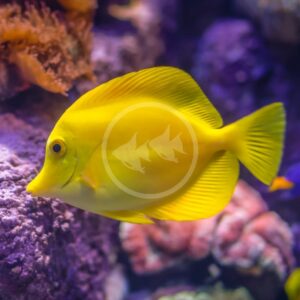

TANG – YELLOW Zebrasoma flavescens
$174.99 – $399.99Price range: $174.99 through $399.99
CICHLID – RAM GERMAN GOLD
Mikrogeophagus ramirezi
$5.99 – $16.99Price range: $5.99 through $16.99
TANG – TOMINIENSIS Ctenochaetus tominiensis
$119.99 – $169.99Price range: $119.99 through $169.99RABBITFISH – MAGNIFICENT FOXFACE Siganus magnificus
$199.99 – $349.99Price range: $199.99 through $349.99

BUTTERFLY – HENIOCHUS BLACK & WHITE Heniochus acuminata
$159.99 – $249.99Price range: $159.99 through $249.99





